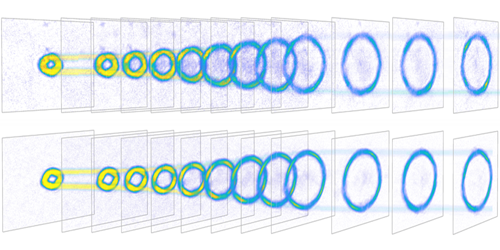An Expanding Universe in the Lab
Cold atoms can be used to emulate physical systems that are hard to study experimentally, like supersolids, superconductors, or black holes. Now, Gretchen Campbell at the University of Maryland, College Park, and co-workers have shown that the rapid expansion of a Bose-Einstein condensate (BEC) exhibits several features reminiscent of those that characterize an expanding universe. They suggest that their BEC system could be used as a laboratory test bed for cosmological theories.
Campbell and her colleagues cooled several hundred thousand sodium-23 atoms to temperatures at which they formed a BEC, and they used lasers to trap the condensate in a ring-shaped potential. They then increased the ring’s radius by a factor of up to 4 over a time period of several tens of milliseconds, causing the BEC to expand at supersonic speeds. From images of the BEC taken during and after the expansion, the team determined the temporal evolution of parameters such as the BEC density and the amplitude and frequency of phonons propagating in the BEC.
The measurements revealed three features analogous to those expected for an expanding universe. First, the wavelengths of the BEC’s phonons increased during the expansion, as in the well-known astronomical redshift effect. Second, the BEC dynamics could only be accurately modeled by including a damping effect similar to “Hubble friction”—a form of friction without dissipation that is often used in models of an expanding universe. Finally, an energy transfer process occurred during the BEC’s expansion, which converted energy from the BEC’s homogeneous radial excitation modes into localized vortices and phonons that heat the BEC. The authors speculate that this energy transfer may be analogous to the “preheating” stage of the early Universe, when the homogenous field driving inflation decayed into a multitude of excitations that subsequently heated the Universe.
This research is published in Physical Review X.
–Matteo Rini
Matteo Rini is the Deputy Editor of Physics.





